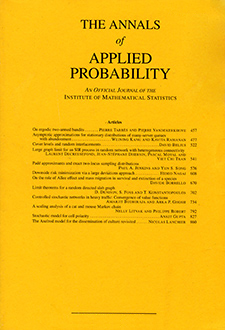Abstract
Given a closed, bounded convex set $\mathcal{W}\subset{\mathbb {R}}^{d}$ with nonempty interior, we consider a control problem in which the state process W and the control process U satisfy $$W_{t}=w_{0}+\int_{0}^{t}\vartheta(W_{s})\,ds+\int_{0}^{t}\sigma(W_{s})\,dZ_{s}+GU_{t}\in \mathcal{W},\qquad t\ge0,$$ where Z is a standard, multi-dimensional Brownian motion, $\vartheta,\sigma\in C^{0,1}(\mathcal{W})$, G is a fixed matrix, and $w_{0}\in\mathcal{W}$. The process U is locally of bounded variation and has increments in a given closed convex cone $\mathcal{U}\subset{\mathbb{R}}^{p}$. Given $g\in C(\mathcal{W})$, κ∈ℝp, and α>0, consider the objective that is to minimize the cost $$J(w_{0},U)\doteq\mathbb{E}\biggl[\int_{0}^{\infty}e^{-\alpha s}g(W_{s})\,ds+\int_{[0,\infty)}e^{-\alpha s}\,d(\kappa\cdot U_{s})\biggr]$$ over the admissible controls U. Both g and κ⋅u ($u\in\mathcal{U}$) may take positive and negative values. This paper studies the corresponding dynamic programming equation (DPE), a second-order degenerate elliptic partial differential equation of HJB-type with a state constraint boundary condition. Under the controllability condition $G\mathcal{U}={\mathbb{R}}^{d}$ and the finiteness of $\mathcal{H}(q)=\sup_{u\in\mathcal{U}_{1}}\{-Gu\cdot q-\kappa\cdot u\}$, q∈ℝd, where $\mathcal{U}_{1}=\{u\in\mathcal{U}:|Gu|=1\}$, we show that the cost, that involves an improper integral, is well defined. We establish the following: (i) the value function for the control problem satisfies the DPE (in the viscosity sense), and (ii) the condition $\inf_{q\in{\mathbb{R}}^{d}}\mathcal{H}(q)< 0$ is necessary and sufficient for uniqueness of solutions to the DPE. The existence and uniqueness of solutions are shown to be connected to an intuitive “no arbitrage” condition.
Our results apply to Brownian control problems that represent formal diffusion approximations to control problems associated with stochastic processing networks.
Citation
Rami Atar. Amarjit Budhiraja. Ruth J. Williams. "HJB equations for certain singularly controlled diffusions." Ann. Appl. Probab. 17 (5-6) 1745 - 1776, October 2007. https://doi.org/10.1214/07-AAP443
Information





